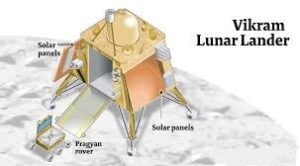Chandrayaan-3 successful landing
After a successful landing, the Chandrayaan-3 mission has marked a significant achievement with the deployment of a six-wheeled Pragyan rover weighing 26 kilograms on the lunar surface. The rover immediately opened its solar panels upon reaching the lunar surface and initiated its journey. This article explores the key highlights of Chandrayaan-3’s landing and the operational aspects of the Pragyan rover.
Pragyan Rover’s Initial Operations
The Pragyan rover is equipped with navigation cameras to scan its surroundings and operates at a speed of 1 cm/second. It opened its solar panels upon landing to start its mission. Over the next 12 days, the rover is expected to cover a journey of nearly half a kilometer, scanning and collecting data from the lunar surface.
Landing Duration and Mission Details
Chandrayaan-3 was launched from Sriharikota, Andhra Pradesh, on July 14th at 3:35 AM.

After a journey of 41 days, it successfully landed on the moon. The total distance from Earth to the moon is approximately 384,000 kilometers.
Payloads and Objectives
The Pragyan rover carries two payloads, the Alpha Particle X-ray Spectrometer (APXS), and the Laser-Induced Breakdown Spectroscope (LIBS). These payloads are designed to analyze the structure of the lunar surface, search for water, and valuable minerals.
Data Transmission and Analysis
Over the next 14 days, the rover will gather data and transmit it to the lander. The data will then be relayed to Chandrayaan-2’s orbiter, which will further transmit it back to Earth for analysis.
Previous Chandrayaan Missions
Chandrayaan-3 marks India’s third lunar mission.

While Chandrayaan-1 discovered water on the moon in 2008, Chandrayaan-2 reached close to the lunar surface in 2019 but couldn’t land successfully. Chandrayaan-3’s landing in 2023 has finally achieved this feat.
Landing Phases
The soft landing of Chandrayaan-3’s lander occurred in four phases:
- Raf Breaking
- Attitude Holding
- Fine Breaking
- Terminal Descent.
These phases involved complex maneuvers to ensure a safe landing on the lunar surface.
Future Endeavors
The success of Chandrayaan-3’s mission is crucial for ISRO’s upcoming projects. The Pragyan rover’s exploration will provide valuable insights into the moon’s environment. ISRO has many missions lined up, including Aditya-L1 (Sun mission) and Gaganyaan (human spaceflight).

The recent success of the Chandrayaan mission has sparked curiosity about its goals and achievements. This article delves into three crucial questions that shed light on India’s lunar exploration endeavor and its broader implications.
The Future of Lunar Exploration
Chandrayaan-3’s lander, Vikram, has already set foot on the moon. The next frontier is the sun. ISRO scientists are preparing for the launch of Aditya-L1 in September, with aspirations to reach the sun. The pursuit of space and the cosmos remains an ongoing, dynamic journey with no foreseeable endpoint.
Question 1: What Will India Gain from This Mission?
By executing this mission, India aims to demonstrate its capability to perform soft landings on the moon and operate rovers. This achievement fosters global confidence in India’s space prowess, which could stimulate commercial opportunities. According to ISRO scientist Manish Purohit, this achievement can bolster India’s standing in the commercial space sector.

Question 2: Why Was the Mission Targeted at the Lunar South Pole?
Unlike other regions, the lunar polar regions present unique challenges, including areas untouched by sunlight and temperatures plummeting to -200 degrees Celsius. Scientists speculate the presence of water ice in these regions due to the absence of sunlight. Chandrayaan-1’s 2008 mission hinted at the presence of water on the moon’s surface.
Question 3: The Quest for Water at the Lunar South Pole
Chandrayaan-3 is specifically tasked with discovering water ice at the lunar south pole. Water in the form of ice could serve as a vital resource for future lunar missions and potential moon colonies, providing oxygen, fuel, and hydration.
Historical Lunar Exploration
The moon, Earth’s only celestial companion, has witnessed over 100 space missions. More than 24 astronauts have explored its surface, with 12 having walked on it. These missions have brought back over 382 kilograms of lunar soil and rocks for experimentation on Earth.
India’s Milestone
India’s soft landing on the moon marks a significant achievement, positioning it as the first country to reach the lunar south pole. Russia’s Luna-25 mission attempted a landing on August 21st but was unsuccessful. Competing in this space race are countries like the United States and China, along with private companies like SpaceX. Exploring the moon has become a global endeavor.

Conclusion
Chandrayaan-3’s historic landing and the deployment of the Pragyan rover mark a significant achievement for India’s space exploration efforts. The successful landing process and the rover’s subsequent operations open doors to further exploration and understanding of the moon’s surface and environment.
Chandrayaan’s triumphant mission to the moon’s south pole addresses crucial questions about India’s aspirations, scientific curiosity, and the potential for future lunar colonization. The successful execution of this mission underscores India’s growing presence in space exploration and its commitment to pushing the boundaries of human knowledge and technological capabilities.
For other related news – https://universenews.co.in/category/science-technology/
Image Courtesy: Google
